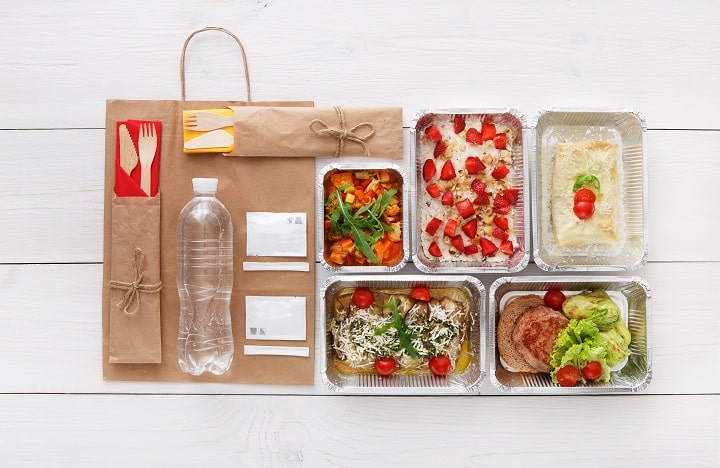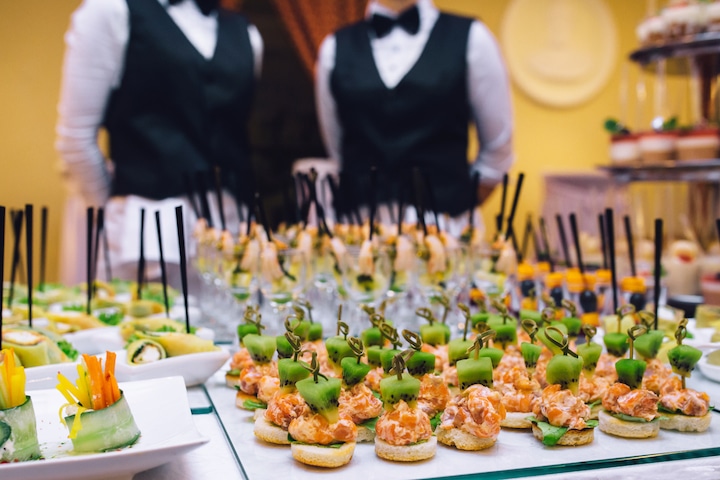Sign up for restaurant insights
Food is everywhere on social media. Spend just a few minutes scrolling and you’ll see restaurants, private chefs and food bloggers showing off their latest creations. It’s easy to see why — highly visual platforms such as Instagram, TikTok and Pinterest are the perfect place to display mouthwatering dishes. If you’re not using social media marketing for your restaurant, it’s time to get posting.
Why is social media marketing important for restaurants?
Social media is critical for your restaurant marketing plan — after all, it’s where your customers are spending time. According to the Pew Research Center, 72% of American adults use at least one social media platform. People between the ages of 18 and 49 are particularly active; more than 80% of this age group use social media regularly. The majority of users visit their preferred platforms at least once every day.
Your customers aren’t just connecting with friends; they’re using social media to search for potential restaurants and make purchasing decisions. An MHG study found that 45% of American diners have decided to try a restaurant because they saw one of its posts on social media.
Building a social media presence takes time, even if you use a social media management company, but it can have a significant impact on your business. Benefits of social media marketing for both large and small restaurants include:
- Increasing brand awareness and brand recognition
- Creating a stronger brand identity
- Converting followers into customers
- Building customer loyalty
- Expanding your audience
- Building social proof
How to choose the right platform
If you’re like most restaurant owners, you don’t have time to maintain profiles on every major social media platform. To maximize your ROI, all you need to do is choose the platform where your target audience is most active. Later, you can expand to other social media channels.
Facebook is the largest social media platform across all age groups, according to Gallup research. About 60% of all Americans aged 18-34 and 55+ use the service daily or weekly, in addition to 66% of people 35-54 years old. No matter your target audience, a Facebook page is a must.
Many users see Facebook as an extension of a brand’s website; they come to check current opening hours, see daily specials and look at the menu. Facebook also allows you to accept reviews, add links, post content and even answer FAQs via chat, so it’s an ideal place to build community.
Instagram is primarily a photo and video-sharing app. The platform is almost entirely visual, so it’s the perfect place to show off your best food photography. Instagram is an effective discovery engine; use appropriate hashtags and location tags to help people find your content. Instafoodies is a growing community, and sharing delectable photos and videos of your cuisine is a sure way to grow a following.
If your audience is between the ages of 18 and 54, Instagram is particularly useful. Gallup finds that the majority of this age group logs in daily or weekly. Customers 55 and older are less active on the app.
TikTok
If you have the resources to film and create short videos, TikTok can be a valuable digital marketing channel for your restaurant. This relatively young video platform is effective at delivering your content to new users, so it’s a good way to reach a bigger audience. To get the most value and exposure, keep up with trending video styles and sounds.
TikTok is a good way to reach younger diners. About 33% of people aged 18-34 use the platform frequently. According to Gallup, it’s also growing in popularity with millennials; 23% of people between the ages of 35 and 54 use the platform.
Twitter is a useful social media marketing tool if you’re ready to engage with the community. The fast-moving feed has a limited character count, so you can share short, easily digestible bits of information. Make sure to allocate time to respond to comments, answer questions, and join in discussions — Twitter is all about conversation.
Twitter is on par with TikTok when it comes to usage, but those stats are likely to change as TikTok grows. Currently, the platform is used daily or weekly by 36% of people 18-34 years old, 23% of people aged 35-54 and 13% of adults aged 55 or older.
Social media marketing tips and tricks
Restaurant social media marketing is flexible. If one post type doesn’t work, you can adjust your social media strategy quickly and cheaply. As a restaurant owner, it’s a good idea to stick to these best practices:
- Stay professional, but establish a unique voice
- Track analytics to identify the best-performing content
- Engage your audience
- Keep up with the latest trends
- Use hashtags to join conversations
1. Create a consistent brand voice
Every time you post on a social media account, use a similar style and tone. Consistency gives your restaurant a distinct personality, which attracts customers and builds familiarity.
If you’re not sure where to start, imagine your restaurant is a person. How would it speak? Would it use slang, or would it be more formal? It’s also helpful to consider the words and tone your target audience will respond to.
2. Share rewards, discounts and limited-time offers
Give your social media followers a reason to visit your restaurant by offering special deals and offers. Add a promo code for online orders, or invite people to follow your profile to get a discount when dining in. You can run promotions during happy hours, food holidays or even slow days of the week.
3. Host a social media contest to build customer loyalty
Social media algorithms reward engagement; if your posts get a high volume of likes, comments and shares, the platform is more likely to show future content to more people. Contests are a fun way to generate more leads and encourage viewers to follow, create user-generated content and interact with your profile.
Keep it simple; you can post a photo and host an informal caption contest, ask people to post their best food photos, or invite followers to name your newest menu item. Offer a prize that boosts business, such as a free meal or branded merchandise. Make sure to cross-promote your social media marketing contest on other channels.
4. Deliver an authentic social media presence
Modern social media users are exceptionally savvy — they respond best to authenticity and enthusiasm. To build stronger connections, showcase the human side of your restaurant. Offer a behind-the-scenes peek into the kitchen, introduce your staff, and explain the meaning behind your restaurant logo. You can also hop on the “no gatekeeping” trend by sharing recipes and cooking tricks.
5. Establish a healthy cadence
A regular posting schedule is essential for social media brand-building; it ensures a steady flow of content. Aim to post at least three times per week, or more if you have the resources.
Consider creating a content calendar to plan posts in advance. That way, you can write content and take photos whenever you have free time. On posting day, all you have to do is hit the “publish” button. Facebook and Instagram even allow you to schedule future posts inside the platform.
6. Reach out to an influencer
Influencer social media marketing is a great way to get your restaurant in front of a new social network. The process is simple: You pay food bloggers and social media personalities to promote your brand to their followers. Stick to people in your area, and don’t be afraid to work with micro influencers; their followings are often small but highly engaged.
7. Try a little video marketing
Video is the most popular and highest-performing social media in 2023, according to HubSpot’s The State of Marketing report. Engagement is particularly high on the short-form videos you’ll find on TikTok and Instagram reels. Try posting cooking tutorials, recipes or even beautiful clips of your top-selling menu items.
8. Respond to online reviews
Social media platforms are public forums; take advantage of that visibility by responding to negative reviews. When you’re professional, friendly and transparent, it builds trust and strengthens relationships. While you’re at it, leverage customer feedback to boost engagement and improve your operations.
9. Showcase menu updates
Social media is one of the most direct channels to reach customers. Instagram and Facebook are often the two common platforms diners check to get updates on your restaurant. Posting about your menu updates, restaurant announcements or seasonal changes can get your latest news to your customers in real time. Letting customers know about your restaurant’s changes can help drum up excitement and give diners a reason to place an order.
10. Increase takeout and delivery sales by promoting online ordering
Customers often scroll social media when they’re trying to choose a restaurant for lunch or dinner. If they see something that appeals to them, they’re likely to order right away. Make it easier by promoting your online ordering options in your posts. Update your social media profile with links to your online ordering website and partner delivery apps. If you’re posting on Twitter or your Facebook page, you can include a clickable link in the post itself.
If you don’t currently have a way for customers to order online, Grubhub Direct is an easy way to build a branded, commission-free ordering website. The Direct Success Playbook can help you increase orders, create special promotions, and improve your marketing.

Social media marketing is a cost-effective way to get your restaurant in front of hungry diners. Start small, post regularly, and don’t be afraid to experiment — it’s a great way to find out what content resonates best with your audience.
Use social media to build a loyal following and increase your restaurant’s sales
Social media is a great marketing tool to help you reach new customers, build a fan base, and increase your restaurant’s sales. From promoting a dine-in special to using commission-free direct ordering links from Grubhub for Restaurants, social media can help increase your restaurant’s sales and build a restaurant brand. Follow @grubhubforrestaurants on Instagram to learn more about how you can market your restaurant.
Need a partner to help get your menu in front of more paying customers? Partner with Grubhub today to reach 33+ hungry diners and grow your business.






